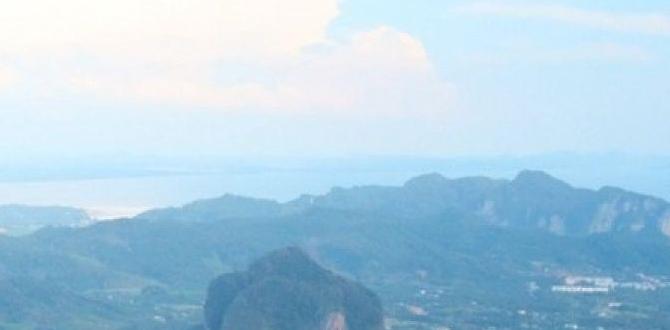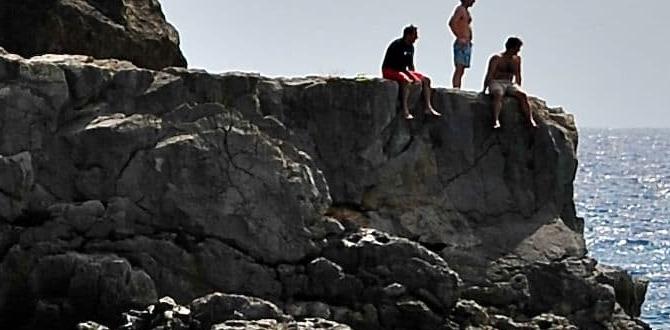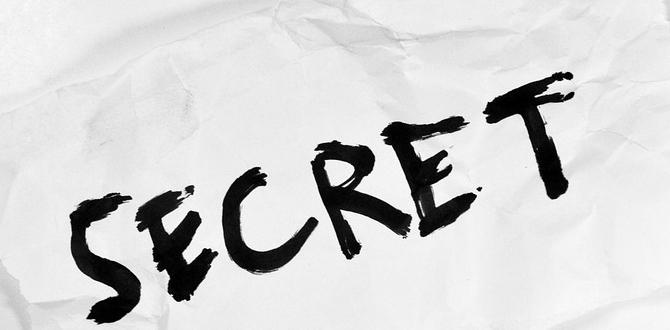Discover Banff’s Best Kept Secrets: Your Essential Guide to Unforgettable Experiences Beyond the Crowds. Explore stunning, less-traveled spots that offer tranquility and unique adventures.
Planning a trip to Banff National Park can feel overwhelming with its famous, bustling attractions. Many visitors flock to the same handful of iconic spots, leading to crowded trails and a less serene experience. It’s easy to feel like you’re missing out on the true magic of this stunning mountain paradise.
But don’t worry! This guide is designed to help you uncover Banff’s best-kept secrets, offering a more personal and peaceful encounter with nature. We’ll walk you through finding those special, off-the-beaten-path locations that make a trip truly unforgettable, ensuring comfort and enjoyment every step of the way. Get ready to explore a different side of Banff!
Banff Hidden Gems Guide: Essential Discoveries
Banff National Park is a jewel in the Canadian Rockies, renowned for its turquoise lakes and majestic peaks. While Lake Louise and Moraine Lake are undeniably breathtaking, they can also be incredibly crowded, especially during peak season.
Finding a bit of solitude and experiencing the park’s quieter side can significantly enhance your trip. As a traveler who cherishes both adventure and peace, I’ve learned that the most memorable moments often come from discovering places just a little off the beaten path. This guide is your key to unlocking those essential, less-obvious wonders.
Why Seek Out Hidden Gems in Banff?
The allure of Banff is undeniable, but the sheer number of visitors means popular spots can feel more like a theme park than a natural escape. Seeking out hidden gems offers several advantages:
Tranquility: Enjoy the serenity of nature without the constant bustle of crowds.
Authenticity: Experience a more genuine connection with the landscape.
Unique Photography: Capture stunning scenes without dozens of other people in your frame.
Wildlife Opportunities: Quieter areas often provide better chances to spot local wildlife safely.
Personal Discovery: The thrill of finding your own special spot is incredibly rewarding.
This guide will help you plan your adventure, ensuring you have the right gear and mindset for discovering these essential Banff treasures.
Getting to Banff: Your Stress-Free Start
Before we delve into the hidden spots, let’s talk about making your journey to Banff smooth. For many, the closest major airport is Calgary International Airport (YYC). From Calgary, you’ll typically rent a car or take a shuttle.
Here’s a simple breakdown for car rental considerations:
Book in Advance: Especially during peak travel times, car rentals can disappear quickly.
Consider SUV: While not always necessary, an SUV can offer better handling on some gravel roads and more space for luggage, and perhaps even discreet storage for personal comfort items like adult diapers or child diapers, giving you peace of mind on long drives.
Check Fuel: Ensure your rental has a full tank and know where the last gas stations are before heading into the park.
If you’re traveling with young children or require discreet personal care, packing essential items like Pampers or Depend can make the journey much more comfortable. Having them easily accessible in a well-organized bag can prevent unnecessary stops and stress.
Essential Gear for Your Banff Adventure
Comfort and preparedness are key whether you’re hitting a famous viewpoint or a secluded trail. Here’s what Journey Essentials recommends:
Comfortable, Broken-In Hiking Boots: Essential for all your explorations.
Layered Clothing: The weather can change rapidly. Think moisture-wicking base layers, insulating mid-layers, and a waterproof/windproof outer shell.
Backpack: A comfortable daypack to carry water, snacks, extra layers, a first-aid kit, and any personal essentials.
Water Bottles or Hydration Pack: Stay hydrated!
Sun Protection: Sunscreen, sunglasses, and a hat are crucial, even on cloudy days.
Bear Spray: Know how to use it and carry it when hiking. Parks Canada offers essential wildlife safety information.
Navigation Tools: A map, compass, or GPS device/app. Don’t rely solely on your phone signal.
Snacks: High-energy options like trail mix, energy bars, and fruit.
Camera: To capture those breathtaking views!
For those needing personal comfort solutions, consider discretely packing specialized items like overnight adult diapers or travel-sized wipes. These can provide an added layer of confidence and security, allowing you to fully immerse yourself in the experience without worry.
Banff Hidden Gems: Unveiling the Less-Traveled Path
These are the spots that offer a different perspective on Banff’s rugged beauty, often with fewer crowds and a more intimate connection with nature.
1. Johnston Canyon (Upper Falls & Ink Pots) – Beyond the Lower Falls
While the Lower Falls of Johnston Canyon draw many visitors, most turn back without venturing further. The real magic, and a bit more peace, lies beyond.
The Hike: From the Lower Falls viewpoint, continue on the trail towards the Upper Falls. This section is less crowded and offers a slightly more challenging but rewarding hike.
The Ink Pots: About 3 km past the Upper Falls, you’ll reach the Ink Pots – five small, mineral-rich pools that glow in vibrant colors. The landscape here opens up into a beautiful meadow, offering a stunning contrast to the dense canyon. The trail to the Ink Pots is a moderate hike.
Why it’s a Gem: The further you go, the fewer people you’ll encounter. The Ink Pots are a unique geological marvel and a peaceful spot to rest.
Traveler Tip: Pack extra water and snacks for the extended hike to the Ink Pots. Ensure your chosen diaper is comfortable and secure for the duration.
Table: Johnston Canyon Comparison
| Feature | Lower Falls Area | Upper Falls & Ink Pots Area |
| Crowd Level | Very High | Moderate to Low |
| Trail Difficulty | Easy (boardwalk) | Easy to Moderate |
| Destination | Iconic waterfall | Waterfall, mineral pools, meadow |
| Time Commitment | 1-2 hours | 3-5 hours |
| Scenery | Dramatic canyon, groomed path | Wider views, unique pools |
| Best For | Quick iconic visit | Nature lovers seeking peace |
2. Peyto Lake Viewpoint (Less Crowded Angles)
Peyto Lake is famous for its wolf-head shape, and the main viewpoint is always packed. However, there are ways to find a quieter experience.
Access: The main viewpoint is a short walk from the parking lot.
The Secret: Instead of staying at the official viewpoint, follow the Bow Summit Lookout Trail further along the ridge. This trail offers various vantage points overlooking Peyto Lake and the surrounding valley.
Why it’s a Gem: The further you walk along the ridge, the more secluded the spots become. You can find quiet nooks to simply sit and absorb the incredible view.
Traveler Tip: Wear sturdy shoes as the terrain can be uneven. This is a great spot for some solo reflection or a quiet family moment.
3. Consolation Lakes Trail
Located near Moraine Lake, this trail offers a stunning alpine lake experience without the extreme crowds of its famous neighbor.
The Hike: This is a relatively easy to moderate hike, about 5.8 km round trip. It starts at the Rockpile at Moraine Lake.
The Destination: The trail winds through a forest and opens up to the breathtaking Consolation Lakes, nestled at the base of towering peaks. The sound of tumbling rocks from the glaciers above is a unique feature.
Why it’s a Gem: It provides the grandeur of Moraine Lake’s surroundings but with a much more manageable number of people. It’s a fantastic option if Moraine Lake Road is open and accessible.
Traveler Tip: Be aware that this trail can sometimes be closed for bear activity. Always check Parks Canada advisories before you go. If you’re dealing with mobility issues or need extra security, having discreet comfort solutions like adult diapers specifically designed for active use can allow you to enjoy trails like this worry-free.
4. Bow Glacier Falls Trail
For those seeking a substantial hike with a rewarding glacial view, Bow Glacier Falls is a superb choice.
The Hike: This is a moderate hike, approximately 9.8 km round trip, starting from the Bow Lake parking area along the Icefields Parkway.
The Destination: The trail leads you through forests and along the Bow River to the impressive Bow Glacier Falls, which tumbles down a massive cliff face. The views of Bow Glacier itself are spectacular.
Why it’s a Gem: It’s a more challenging hike than many accessible viewpoints, naturally filtering out the casual crowds giving you a more peaceful experience amidst immense natural beauty. The sheer scale of the glacier and falls is awe-inspiring.
Traveler Tip: This hike requires good footwear and can be muddy or snowy early/late in the season. Pack bear spray and be prepared for a longer outing.
5. Parker Ridge Trail
If you’re traveling anywhere on the Icefields Parkway (Highway 93 North), this hike is an absolute must for panoramic views.
The Hike: A relatively short but steep hike (around 5.4 km round trip) that gains elevation quickly.
The Destination: The payoff is immense. You reach a ridge overlooking the vast Saskatchewan Glacier and the surrounding mountain ranges. It feels like you’re on top of the world.
Why it’s a Gem: While popular with those driving the Parkway, it’s not as heavily trafficked as Lake Louise or Moraine Lake. The views are arguably some of the best in Banff National Park and feel incredibly remote once you’re at the summit.
Traveler Tip: The trail can be windy and exposed. Bring layers, including a windbreaker. This is a fantastic spot for capturing sunrise or sunset if you’re equipped for the conditions.
6. Emerald Lake (Yoho National Park – Close to Banff)
While technically in Yoho National Park, Emerald Lake is a short drive west from Banff townsite and offers a dramatically less crowded, equally stunning experience.
The Gem: Emerald Lake is named for its incredibly vivid green waters, a result of glacial silt. It’s surrounded by dramatic peaks and ancient forests.
Activities: You can rent a canoe for a serene paddle on the lake, walk the easy paved path around its perimeter, or tackle the more challenging hike up to the Natural Bridge.
Why it’s a Gem: It often gets overlooked by those focused solely on Banff’s core attractions. The color of the lake is mesmerizing, and the atmosphere is much calmer.
Traveler Tip: Visit early in the morning or later in the afternoon to avoid the midday tour bus crowds. Like any nature outing, carrying essential comfort items discreetly can enhance enjoyment.
7. Stanley Glacier Trail
Another gem accessible from the Kootenay National Park side (a short drive from Banff’s southern entrance). This trail offers a unique glimpse into recent geological history.
The Hike: A moderate hike, approximately 8.4 km round trip, that leads into a hanging valley.
The Destination: You’ll hike past alpine meadows and eventually reach an area shaped by a massive ancient glacier. The highlight is walking among the moraines left behind by the retreating Stanley Glacier.
Why it’s a Gem: It’s less visited than many Banff trails, offering a genuine sense of discovery. The landscape is starkly beautiful and provides a different kind of mountain experience. This trail showcases the power of glaciers and their impact on the land.
Traveler Tip: Be prepared for all types of weather and carry bear spray. This is a perfect trail for those who appreciate geological wonders.
Planning Your Banff Hidden Gems Itinerary
Combining these hidden gems with the famous sites can create a balanced and deeply satisfying Banff experience. Here’s how to approach it:
Sample 3-Day Itinerary (Beginner Friendly):
This is just a suggestion to get you started. Feel free to adjust based on your interests and energy levels.
Day 1: Iconic Views & Gentle Exploration
Morning: Visit Lake Louise early. Walk the paved path along the shoreline. Consider a short, easy walk towards Mirror Lake.
Afternoon: Head to Moraine Lake (if accessible – check Parks Canada for shuttle/road status). Take photos from the Rockpile.
Late Afternoon: Drive ~30 minutes west to Emerald Lake in Yoho National Park. Enjoy the lake’s beauty and perhaps a short walk.
Day 2: Canyons & Glacial Wonders
Morning: Explore Johnston Canyon, hiking beyond the Lower Falls to the Upper Falls. If time and energy permit, continue to the Ink Pots.
Afternoon: Drive south on Highway 93 (Banff-Windermere Parkway) into Kootenay National Park to hike the Stanley Glacier Trail.
Evening: Relax in Banff townsite, find a nice dinner.
Day 3: High Alpine & Parkway Scenery
Morning: Drive north on the Icefields Parkway. Stop at Peyto Lake viewpoint and explore the less crowded trails along the ridge.
Afternoon: Continue on the Icefields Parkway to hike the Parker Ridge Trail for stunning glacier views.
Late Afternoon: On your return drive, stop at Bow Lake for lakeside views and consider a brief walk.
Tips for a Comfortable Trip
For any traveler, comfort is paramount. Before you go, ensure you’ve packed items that cater to your personal needs. If you require specific personal care items, like discreetly packaged adult diapers for managing incontinence, or child diapers for little ones, make sure they are readily available and packed efficiently. Having a small, waterproof bag within your main backpack can keep these items secure and dry, offering peace of mind throughout your adventures.
Banff Lake Louise Tourism offers a wealth of information on activities and attractions that can complement your exploration.
Beyond the Trails: Other Hidden Gems
Banff’s charm extends beyond organized hikes.
Scenic Drives with Quiet Pull-offs
The Icefields Parkway is world-famous, but many pull-offs are less visited. Explore areas like Waterfowl Lakes picnic area or commentate the smaller viewpoints. These offer stunning perspectives with fewer distractions.
Banff Avenue’s Local Eateries
While chain restaurants exist, seek out smaller cafes and bakeries on Banff Avenue or side streets. They often offer delicious local flavors and a more authentic vibe. Try Park Distillery for a unique craft spirit experience or find a cozy cafe for a morning coffee.
Vermilion Lakes at Sunrise/Sunset
While visible from town, finding a quiet spot along the scenic drive beside Vermilion Lakes can offer spectacular reflections of Mount Rundle, especially at sunrise or sunset, with far fewer people than the famous lake spots.
Wildlife Safety in Banff
Encountering wildlife is a possibility. Remember these key points:
Maintain Distance: Never approach or feed wildlife.
Bear Awareness: Carry bear spray and know how to use it. Make noise on trails.
Report Sightings: Inform Parks Canada or park staff of any wildlife encounters.
Secure Food: Keep food and garbage sealed and away from animals.
Parks Canada’s commitment to visitor safety is evident in their comprehensive resources available on their official website regarding wildlife.
Sustainable Travel in Banff
To preserve the magic of Banff for future generations, practice responsible tourism:
Leave No Trace: Pack out everything you pack in.
Stay on Trails: Protect fragile ecosystems.
Reduce Waste: Use reusable water bottles and bags.
Respect Wildlife: Observe from a distance.
* Be Mindful of Your Impact: Consider transportation; carpooling or using shuttles can help.
Frequently Asked Questions (FAQ)
Q1: What months are best for visiting Banff’s hidden gems?
Late spring (June) through early fall (September) generally offers the best weather for hiking and accessing most trails. However, shoulder seasons (May and October) can offer fewer crowds and beautiful scenery, but be prepared for variable weather and potential snow at higher elevations.
Q2: Do I need a Parks Canada Pass?
Yes, you need a Parks Canada Discovery Pass to visit any national park, including Banff. You can purchase it online or at park gates. It’s essential for legal access.
Q3: How do I access Moraine Lake and Lake Louise if I don’t have a car or parking is full?
Parks Canada operates a shuttle service to both Lake Louise and Moraine Lake. Reservations are highly recommended and often required. Private tour operators and local transit services also offer access. Check the Parks Canada website for the most up-to-date information on transportation and reservations.
Q4: What if I need extra support for personal comfort during long hikes?
For travelers who might need discreet personal care solutions, bringing along specialized products like overnight adult diapers or period-proof underwear can significantly enhance comfort and confidence. Ensuring you have a secure, reliable product designed for active use is key. Packing these in a waterproof bag within your daypack allows for easy and discreet changes if needed.
Q5: Are dogs allowed on trails in Banff National Park?
Dogs are generally allowed on most trails in Banff National Park, but they must be kept on a leash at all times. They are not permitted in backcountry campgrounds or on certain sensitive trails. Always check specific park regulations before heading out with your





